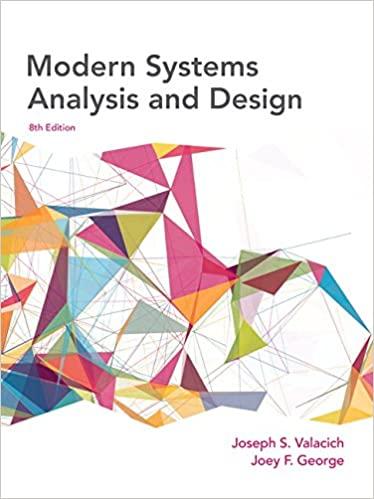Part 1: Short questions. A short, precise and concise answer will obtain full credit. (NB: We will take the seven highest grades of your
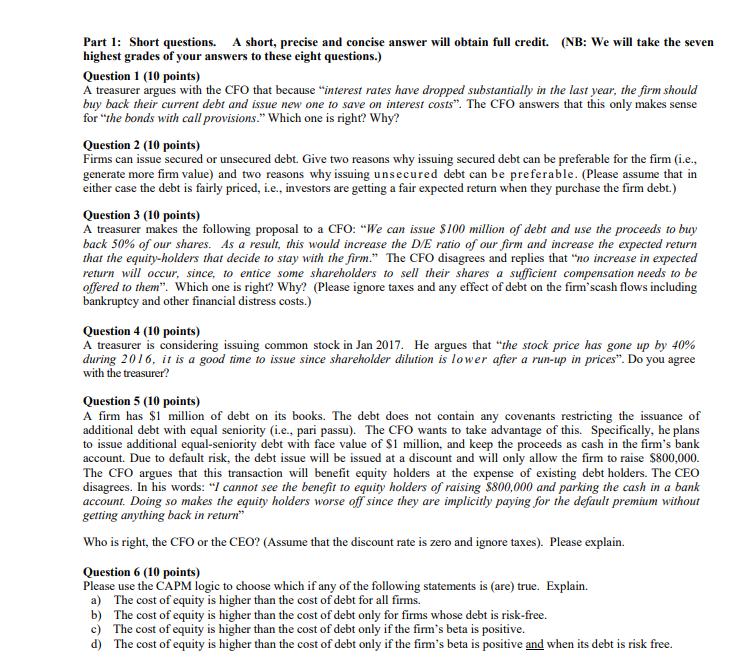
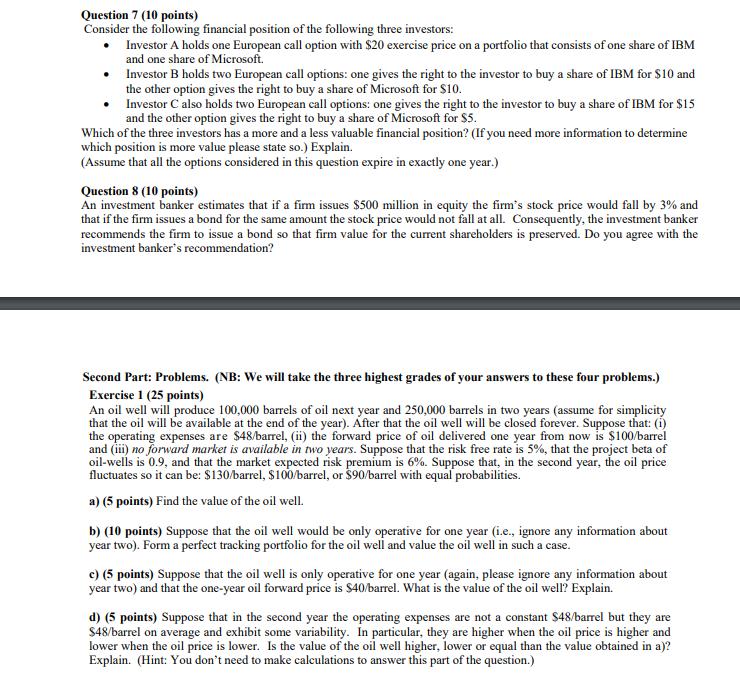
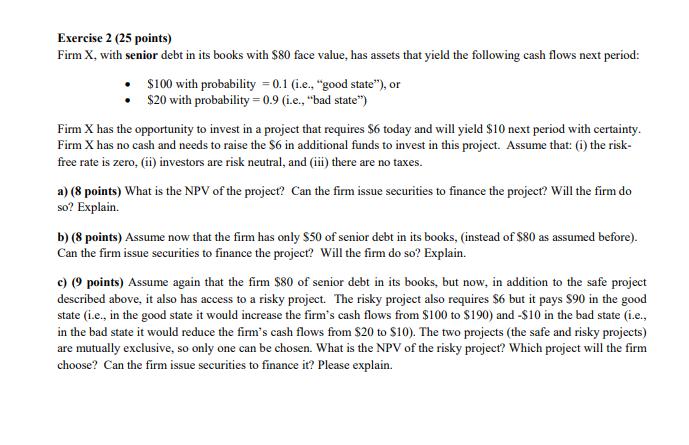
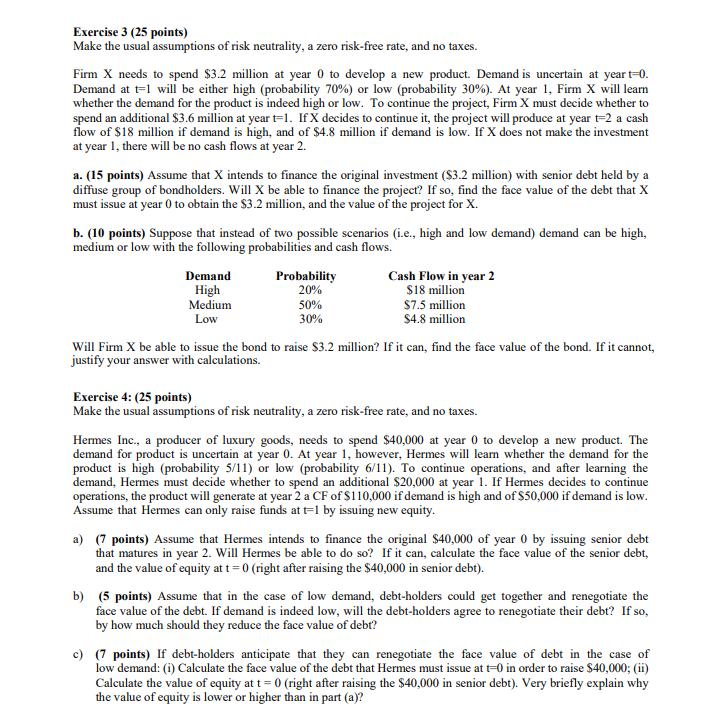

Part 1: Short questions. A short, precise and concise answer will obtain full credit. (NB: We will take the seven highest grades of your answers to these eight questions.) Question 1 (10 points) A treasurer argues with the CFO that because "interest rates have dropped substantially in the last year, the firm should buy back their current debt and issue new one to save on interest costs". The CFO answers that this only makes sense for "the bonds with call provisions." Which one is right? Why? Question 2 (10 points) Firms can issue secured or unsecured debt. Give two reasons why issuing secured debt can be preferable for the firm (i.e., generate more firm value) and two reasons why issuing unsecured debt can be preferable. (Please assume that in either case the debt is fairly priced, i.e., investors are getting a fair expected return when they purchase the firm debt.) Question 3 (10 points) A treasurer makes the following proposal to a CFO: "We can issue $100 million of debt and use the proceeds to buy back 50% of our shares. As a result, this would increase the D/E ratio of our firm and increase the expected return that the equity-holders that decide to stay with the firm." The CFO disagrees and replies that "no increase in expected return will occur, since, to entice some shareholders to sell their shares a sufficient compensation needs to be offered to them". Which one is right? Why? (Please ignore taxes and any effect of debt on the firm'scash flows including bankruptcy and other financial distress costs.) Question 4 (10 points) A treasurer is considering issuing common stock in Jan 2017. He argues that "the stock price has gone up by 40% during 2016, it is a good time to issue since shareholder dilution is lower after a run-up in prices". Do you agree with the treasurer? Question 5 (10 points) A firm has $1 million of debt on its books. The debt does not contain any covenants restricting the issuance of additional debt with equal seniority (i.e., pari passu). The CFO wants to take advantage of this. Specifically, he plans to issue additional equal-seniority debt with face value of $1 million, and keep the proceeds as cash in the firm's bank account. Due to default risk, the debt issue will be issued at a discount and will only allow the firm to raise $800,000. The CFO argues that this transaction will benefit equity holders at the expense of existing debt holders. The CEO disagrees. In his words: "I cannot see the benefit to equity holders of raising $800,000 and parking the cash in a bank account. Doing so makes the equity holders worse off since they are implicitly paying for the default premium without getting anything back in return" Who is right, the CFO or the CEO? (Assume that the discount rate is zero and ignore taxes). Please explain. Question 6 (10 points) Please use the CAPM logic to choose which if any of the following statements is (are) true. Explain. a) The cost of equity is higher than the cost of debt for all firms. b) The cost of equity is higher than the cost of debt only for firms whose debt is risk-free. c) The cost of equity is higher than the cost of debt only if the firm's beta is positive. d) The cost of equity is higher than the cost of debt only if the firm's beta is positive and when its debt is risk free. Question 7 (10 points) Consider the following financial position of the following three investors: Investor A holds one European call option with $20 exercise price on a portfolio that consists of one share of IBM and one share of Microsoft. Investor B holds two European call options: one gives the right to the investor to buy a share of IBM for $10 and the other option gives the right to buy a share of Microsoft for $10. Investor C also holds two European call options: one gives the right to the investor to buy a share of IBM for $15 and the other option gives the right to buy a share of Microsoft for $5. Which of the three investors has a more and a less valuable financial position? (If you need more information to determine which position is more value please state so.) Explain. (Assume that all the options considered in this question expire in exactly one year.) Question 8 (10 points) An investment banker estimates that if a firm issues $500 million in equity the firm's stock price would fall by 3% and that if the firm issues a bond for the same amount the stock price would not fall at all. Consequently, the investment banker recommends the firm to issue a bond so that firm value for the current shareholders is preserved. Do you agree with the investment banker's recommendation? Second Part: Problems. (NB: We will take the three highest grades of your answers to these four problems.) Exercise 1 (25 points) An oil well will produce 100,000 barrels of oil next year and 250,000 barrels in two years (assume for simplicity that the oil will be available at the end of the year). After that the oil well will be closed forever. Suppose that: (1) the operating expenses are $48/barrel, (ii) the forward price of oil delivered one year from now is $100/barrel and (iii) no forward market is available in two years. Suppose that the risk free rate is 5%, that the project beta of oil-wells is 0.9, and that the market expected risk premium is 6%. Suppose that, in the second year, the oil price fluctuates so it can be: $130/barrel, $100/barrel, or $90/barrel with equal probabilities. a) (5 points) Find the value of the oil well. b) (10 points) Suppose that the oil well would be only operative for one year (i.e., ignore any information about year two). Form a perfect tracking portfolio for the oil well and value the oil well in such a case. c) (5 points) Suppose that the oil well is only operative for one year (again, please ignore any information about year two) and that the one-year oil forward price is $40/barrel. What is the value of the oil well? Explain. d) (5 points) Suppose that in the second year the operating expenses are not a constant $48/barrel but they are $48/barrel on average and exhibit some variability. In particular, they are higher when the oil price is higher and lower when the oil price is lower. Is the value of the oil well higher, lower or equal than the value obtained in a)? Explain. (Hint: You don't need to make calculations to answer this part of the question.) Exercise 2 (25 points) Firm X, with senior debt in its books with $80 face value, has assets that yield the following cash flows next period: $100 with probability = 0.1 (i.e., "good state"), or $20 with probability = 0.9 (i.e., "bad state") Firm X has the opportunity to invest in a project that requires $6 today and will yield $10 next period with certainty. Firm X has no cash and needs to raise the $6 in additional funds to invest in this project. Assume that: (i) the risk- free rate is zero, (ii) investors are risk neutral, and (iii) there are no taxes. a) (8 points) What is the NPV of the project? Can the firm issue securities to finance the project? Will the firm do so? Explain. b) (8 points) Assume now that the firm has only $50 of senior debt in its books, (instead of $80 as assumed before). Can the firm issue securities to finance the project? Will the firm do so? Explain. c) (9 points) Assume again that the firm $80 of senior debt in its books, but now, in addition to the safe project described above, it also has access to a risky project. The risky project also requires $6 but it pays $90 in the good state (i.e., in the good state it would increase the firm's cash flows from $100 to $190) and -$10 in the bad state (i.e., in the bad state it would reduce the firm's cash flows from $20 to $10). The two projects (the safe and risky projects) are mutually exclusive, so only one can be chosen. What is the NPV of the risky project? Which project will the firm choose? Can the firm issue securities to finance it? Please explain. Exercise 3 (25 points) Make the usual assumptions of risk neutrality, a zero risk-free rate, and no taxes. Firm X needs to spend $3.2 million at year 0 to develop a new product. Demand is uncertain at year t=0. Demand at t=1 will be either high (probability 70%) or low (probability 30%). At year 1, Firm X will learn whether the demand for the product is indeed high or low. To continue the project, Firm X must decide whether to spend an additional $3.6 million at year t=1. If X decides to continue it, the project will produce at year t-2 a cash flow of $18 million if demand is high, and of $4.8 million if demand is low. If X does not make the investment at year 1, there will be no cash flows at year 2. a. (15 points) Assume that X intends to finance the original investment ($3.2 million) with senior debt held by a diffuse group of bondholders. Will X be able to finance the project? If so, find the face value of the debt that X must issue at year 0 to obtain the $3.2 million, and the value of the project for X. b. (10 points) Suppose that instead of two possible scenarios (i.e., high and low demand) demand can be high, medium or low with the following probabilities and cash flows. Demand High Medium Low Probability 20% 50% 30% Cash Flow in year 2 $18 million $7.5 million $4.8 million Will Firm X be able to issue the bond to raise $3.2 million? If it can, find the face value of the bond. If it cannot, justify your answer with calculations. Exercise 4: (25 points) Make the usual assumptions of risk neutrality, a zero risk-free rate, and no taxes. Hermes Inc., a producer of luxury goods, needs to spend $40,000 at year 0 to develop a new product. The demand for product is uncertain at year 0. At year 1, however, Hermes will learn whether the demand for the product is high (probability 5/11) or low (probability 6/11). To continue operations, and after learning the demand, Hermes must decide whether to spend an additional $20,000 at year 1. If Hermes decides to continue operations, the product will generate at year 2 a CF of $110,000 if demand is high and of $50,000 if demand is low. Assume that Hermes can only raise funds at t-1 by issuing new equity. a) (7 points) Assume that Hermes intends to finance the original $40,000 of year 0 by issuing senior debt that matures in year 2. Will Hermes be able to do so? If it can, calculate the face value of the senior debt, and the value of equity at t=0 (right after raising the $40,000 in senior debt). b) (5 points) Assume that in the case of low demand, debt-holders could get together and renegotiate the face value of the debt. If demand is indeed low, will the debt-holders agree to renegotiate their debt? If so, by how much should they reduce the face value of debt? c) (7 points) If debt-holders anticipate that they can renegotiate the face value of debt in the case of low demand: (i) Calculate the face value of the debt that Hermes must issue at t=0 in order to raise $40,000; (ii) Calculate the value of equity at t=0 (right after raising the $40,000 in senior debt). Very briefly explain why the value of equity is lower or higher than in part (a)? d) (6 points) Now assume that in the case of high demand, if Hermes spends the additional $20,000 at year 1, the shareholders can take one of two alternative projects: A safe project, that as before, yields a CF of $110,000 at t=2. A risky project that yields a CF of $140,000 or $0 at t=2 with equal probability (i.e., 0.5) Hermes plans to finance as much as possible of the initial investment by issuing senior debt and the rest by issuing equity. Up to how much of the initial $40,000 can Hermes finance with senior debt? (Note: In part (d) assume that in the case of low demand renegotiation does NOT take place).
Step by Step Solution
3.45 Rating (152 Votes )
There are 3 Steps involved in it
Step: 1
Question 1 10 points True the CFO This only makes sense for bonds that have call provisions since the company can buy them back at a discount and then issue new bonds with a lower interest rate Questi...
See step-by-step solutions with expert insights and AI powered tools for academic success
Step: 2

Step: 3

Ace Your Homework with AI
Get the answers you need in no time with our AI-driven, step-by-step assistance
Get Started


